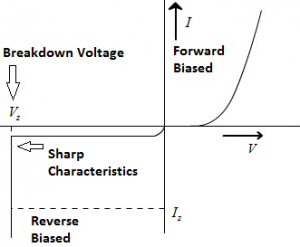Zener Breakdown
If the reverse – bias applied to a p – n junction is increased, a point will reach when the junction breaks down and reverse current rises sharply to a value limited only by the external resistance connected in series. This specific value of the reverse bias voltage is called breakdown voltage (V).
If the reverse biased voltage is too high, then breakdown of p – n junction diode occurs. It is of following two types:
- Zener Breakdown.
- Avalanche Breakdown.
What is a Zener Breakdown?
When reverse bias is increased the electric field across the junction also increases. The Zener Breakdown is observed in the Zener diodes having Vz less than 5V or between 5 to 8 Volts. When a reverse voltage is applied to a Zener diode, it causes a very intense electric field to appear across a narrow depletion region. Such an intense electric field is strong enough to pull some of the valence electrons into the conduction band by breaking their covalent bonds. A large number of such free electrons will constitute a large reverse current through the Zener diode and breakdown is said to have occurred due to the Zener effect.
Characteristics of Zener Breakdown:
A current limiting resistance should be connected in series with the Zener diode to protect it against the damage due to excessive heating. In Zener breakdown, the breakdown voltage depends in the temperature of p – n junction. The breakdown voltage decreases with increase in the junction temperature.

